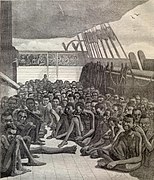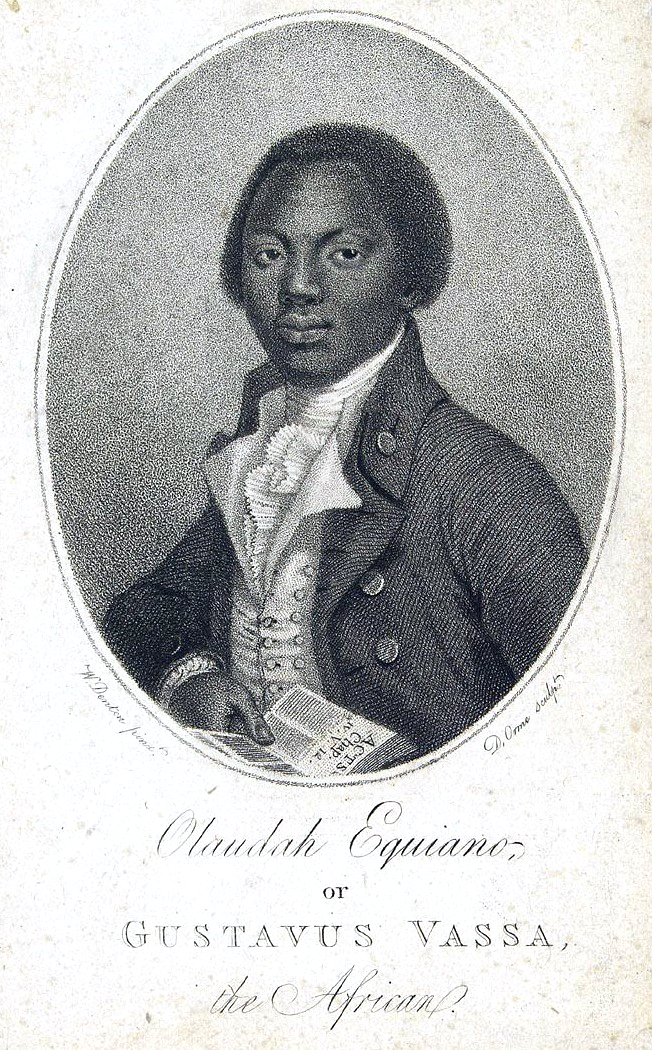Percentage of colonial population enslaved, 1770

Topics on the Page
Overview of the Atlantic Slave Trade
Slavery in the New England Colonies
- Rhode Island and the Slave Trade
- Massachusetts and the Slave Trade
Causes of African Slavery in the American Colonies
The Middle Passage
The Triangular Trade
Free African Americans in the Colonies
- Crispus Attucks
- Olaudah Equiano
- Phillis Wheatley
- Amos Fortune
Resistance Narratives
CROSS-LINK: The Abolition of Slavery in the North after the American Revolution
"The African slave who sailed to the New World did not sail alone. People bought their culture, no matter how adverse the circumstances, and therefore part of American is African."
Henry Louis Gates,Jr.
 Focus Questions:
Focus Questions:
-
What were the causes of slavery in North America?
-
What was the experience of African Americans during the Middle Passage and slave life and how did they respond to their condition?
-
What was the experience of free African Americans in the colonies?
Overview of the Slave Trade

-
Between 1501 and 1867, nearly 13 million African people were kidnapped, forced onto European and American ships, and trafficked across the Atlantic Ocean to be enslaved, abused, and forever separated from their homes, families, and cultures.
-
European powers initiated and maintained the Atlantic Slave Trade to the Americas, with British, French, and Spanish colonists transporting enslaved Africans across the Middle Passage between 1640 and 1807.
-
The Middle Passage was the harrowing voyage experienced by millions of African captives across the Atlantic. The conditions were grotesque and appalling, with large numbers of people crammed into very small spaces and families torn apart. Overcrowding, poor diet, dehydration and disease led to high death rates.

-
Emerging colonial communities in North America relied on the enslavement and forced labor of Black people to grow their economies. These places included New England, Boston, New York City, the Mid-Atlantic, Virginia, Richmond, the Carolinas, Charleston, Savannah, the Deep South, and New Orleans.
 Check out these links for more information about the Atlantic Slave Trade.
Check out these links for more information about the Atlantic Slave Trade.
 Click here for a cross-link to the Origins of the Atlantic Slave Trade.
Click here for a cross-link to the Origins of the Atlantic Slave Trade.
 Click here for a Ted-Ed on the Atlantic Slave Trade.
Click here for a Ted-Ed on the Atlantic Slave Trade.
 Click here for an interactive timeline of slavery in America.
Click here for an interactive timeline of slavery in America.
 Click here to learn about freedom and bondage in the colonial era.
Click here to learn about freedom and bondage in the colonial era.
Slavery in the New England Colonies

-
With the lack of large plantations in the New England colonies, the White colonists of these northern colonies usually only kept one or two enslaved people who worked in their households, for their businesses, or on their small farms.
-
New England had indentured servants alongside their enslaved African people. An indentured servant was a person who had signed an agreement to work for several years in exchange for a trip to the colonies. Before 1641, enslaved Africans had the same rights as indentured servants, but after the Massachusetts Bay Colony passed new laws, enslaved African people lost a few of their rights.

 Click here to learn more about slavery in the New England Colonies.
Click here to learn more about slavery in the New England Colonies.
 Click here for information on the Massachusetts Body of Liberties (1641) and the Massachusetts Bay Colony’s legalization of slavery.
Click here for information on the Massachusetts Body of Liberties (1641) and the Massachusetts Bay Colony’s legalization of slavery.
 Click here for an interactive map of enslaved African Americans in Deerfield, Massachusetts in the eighteenth century.
Click here for an interactive map of enslaved African Americans in Deerfield, Massachusetts in the eighteenth century.
 Click here for the book New England Bound: Slavery and Colonization in Early America
Click here for the book New England Bound: Slavery and Colonization in Early America
 Click here for a learning plan on slavery in the colonial North.
Click here for a learning plan on slavery in the colonial North.
Rhode Island and the Slave Trade
- Teacher Tom Goldscheider provided these notes about Rhode Island and New England’s leading role in the slave trade.

-
The DeWolfe family, based in Bristol, Rhode Island, made up the largest slave-holding dynasty in early America. James DeWolfe became the second richest man in America and a U. S. Senator. The family controlled a vertically integrated business empire that included ships, slaves, sugar plantations, warehouses for storing molasses, distilleries for turning molasses into rum, insurance companies and banks.
-
By 1750, there were upwards to 11,000 slaves in New England (in contrast to 800,000 imported to the Caribbean at the time). Slavery had been introduced in New England as early as 1638 and by 1715 one of every five slaves was held in the North. By 1750, one of every nine residents of Rhode Island was a slave; in South Kingston, Rhode Island the ratio was one to three.
-
Four governors, two LT. governors, and numerous assembly members and judges made their fortune in the slave trade as did John Brown, the principal founder of Brown University.
 Click here for more information on the slave trade in Rhode Island.
Click here for more information on the slave trade in Rhode Island.
Massachusetts and Slavery

-
Massachusetts was the first slave-holding colony in America. In 1641, the colonial governor, John Winthrop, helped to write the first law legalizing slavery in North America.
-
Elizabeth Freeman, better known as Mum Bett, was the first enslaved African person to successfully sue for her freedom after her enslaver beat her with a shovel. This case would help to set the abolition movement in motion. Bett was the great-grandmother of W.E.B. Du Bois.
 Click here to read more about Mum Bett and her historic case.
Click here to read more about Mum Bett and her historic case.
 Click here for more information on the city’s role in the Underground Railroad.
Click here for more information on the city’s role in the Underground Railroad.
 Click here for more information on slavery in Massachusetts.
Click here for more information on slavery in Massachusetts.
Causes of African Slavery in the American Colonies

Causes of African slavery in the American colonies included:
- beliefs that African slaves were better workers than Indian slaves
- diseases that killed many Indian populations and created the need for a new source of labor
- attempts by colonies to forge alliance with the Natives
- an increase in trade routes (particularly the Triangular Trade)
- the inexpensiveness of African slaves
- an increase in demand for agriculture and trade meant the colonists needed more help
The Middle Passage

-
Slaver captains chiefly anchored off the Guinea Coast and traded for cargoes of 150-600 people. The conditions on these slave ships were wretched and dehumanizing. Enslaved Africans suffered physical, sexual, and psychological abuse and were often shackled together for the entire journey.
-
In order to carry the maximum number of enslaved Africans, captives were wedged tightly together and only allowed a space six feet long, sixteen inches wide, and three feet high. These conditions prompted the spread of disease.

 Click here to learn more about the Middle Passage.
Click here to learn more about the Middle Passage.
 Click here and scroll down to “Voices of the Middle Passage” to read first-hand accounts of the horrors of the Middle Passage.
Click here and scroll down to “Voices of the Middle Passage” to read first-hand accounts of the horrors of the Middle Passage.
- There are individual accounts are from Belinda Sutton, Olaudah Equiano, Alexander Falconbridge, Austin Bearse, and George Henry Moore. All of the names have drop-down arrows that allow viewers to read the words of these people regarding the Middle Passage
 Click here to learn about the wreck of the Henrietta Marie and its contributions to the history of the Atlantic Slave Trade.
Click here to learn about the wreck of the Henrietta Marie and its contributions to the history of the Atlantic Slave Trade.
 Click here to watch “The Middle Passage” documentary by Steven Spielberg.
Click here to watch “The Middle Passage” documentary by Steven Spielberg.
 Click here to watch a clip from the movie Amistad depicting the Middle Passage.
Click here to watch a clip from the movie Amistad depicting the Middle Passage.
The Triangular Trade

-
The first leg of trade began in Europe, with manufactured goods such as metals, brass dishes, knives, tools, textiles, firearms, ammunition, and alcoholic beverages being transported to the coast of Western Africa. These goods were exchanged for enslaved people.
-
The second leg of trade was the shipment of these enslaved Africans across the Atlantic Ocean to the Americas. This stage is also known as the Middle Passage. Once the captives arrived in Brazil or the Caribbean, they were sold at auctions and taken throughout the New World. The majority of these enslaved Africans were put to work on plantations and forced into agricultural work. On these plantations, the enslaved produced sugar, rice, indigo, tobacco, cotton, molasses, and rum—all of which were valuable exports to Europe.

-
The third leg distinctly involved the British colonies, as the raw materials that were cultivated by the enslaved Africans were sent across the Atlantic to Britain. In return for the raw materials, Europe would send manufactured goods and luxury items back to the colonies and would export other goods to Africa to continue to continue the cycle of trade.
 Click here to learn more about the Triangular Trade.
Click here to learn more about the Triangular Trade.
 Click here for a kid-friendly source on the Triangular Trade.
Click here for a kid-friendly source on the Triangular Trade.
 Click here for a Khan Academy video on the Triangular Trade.
Click here for a Khan Academy video on the Triangular Trade.
Free African Americans in the Colonies

- There were relatively few African Americans to achieve freedom in colonial America. And concerning the ones who were able to attain it, they rarely received equal treatment.

- There were a couple ways that African Americans could gain their freedom, including
- buying freedom from skilled work
- escaping slavery
- manumission (the voluntary freeing of a slave by their enslaver)
- Among the free African Americans were Crispus Attucks, Olaudah Equiano, Phillis Wheatley, and Amos Fortune.
- Crispus Attucks escaped slavery by running away from his enslaver. He is most well-known for being shot and killed during the Boston Massacre and being considered the first American to die during the American Revolution.
 Click here to learn more about Crispus Attucks.
Click here to learn more about Crispus Attucks.

- Olaudah Equiano was sold into slavery at age 11. Bought by Michael Henry Pascal, a lieutenant in the Royal Navy, Equiano would spend the following seven years with Pascal. He moved to England, educated himself, and traveled with Pascal around the world. In 1766, Equiano was able to buy his freedom.
 Click here for more information on Olaudah Equiano.
Click here for more information on Olaudah Equiano.
 Click here to read Olaudah Equiano’s autobiography: The Interesting Narrative of The Life of Olaudah Equiano or Gustavus Vassa, The African.
Click here to read Olaudah Equiano’s autobiography: The Interesting Narrative of The Life of Olaudah Equiano or Gustavus Vassa, The African.

- Phillis Wheatley was seized from Senegal/Gambia, West Africa when she was about seven years old. She was sold to John and Susanna Wheatley in 1761. Phillis performed domestic labor and was taught to read and write by her enslavers. She would begin to write poetry and gained international acclaim for her work. In 1774, Wheatley was manumitted by her enslavers, as they were pressured by readers to free her.
 Click here to learn more about Phillis Wheatley.
Click here to learn more about Phillis Wheatley.
 Click here to read some of Phillis Wheatley’s poems.
Click here to read some of Phillis Wheatley’s poems.
- Amos Fortune was an enslaved African American who was able to buy his freedom and the freedom of his two wives. He was a tanner by profession and was able to make enough money to purchase three freedoms.
 Click here to learn more about Amos Fortune.
Click here to learn more about Amos Fortune.
 Click here to learn more about free African Americans in the Colonial Era.
Click here to learn more about free African Americans in the Colonial Era.
 Click here for a lesson plan on the “freedom fever” that swept across the colonies prior to the Revolutionary War.
Click here for a lesson plan on the “freedom fever” that swept across the colonies prior to the Revolutionary War.
 Click here to read more about the lives of free African Americans in the colonies and their accomplishments and collective engagements.
Click here to read more about the lives of free African Americans in the colonies and their accomplishments and collective engagements.
 Click here to learn more about Lord Dunmore’s Proclamation of 1775, which many enslaved Africans took advantage of in hopes to achieve their freedom.
Click here to learn more about Lord Dunmore’s Proclamation of 1775, which many enslaved Africans took advantage of in hopes to achieve their freedom.
 Click here to learn more about free African Americans in colonial Virginia.
Click here to learn more about free African Americans in colonial Virginia.
Liberation Narratives and Personal Narratives

 Click here for information on slave rebellions in the Americas.
Click here for information on slave rebellions in the Americas.
 Click here to read A Narrative of Uncommon Sufferings, and Surprising Deliverance of Briton Hammon, A Negro Man (1760), the first slave narrative published by an African American in the New World.
Click here to read A Narrative of Uncommon Sufferings, and Surprising Deliverance of Briton Hammon, A Negro Man (1760), the first slave narrative published by an African American in the New World.
Comments (0)
You don't have permission to comment on this page.